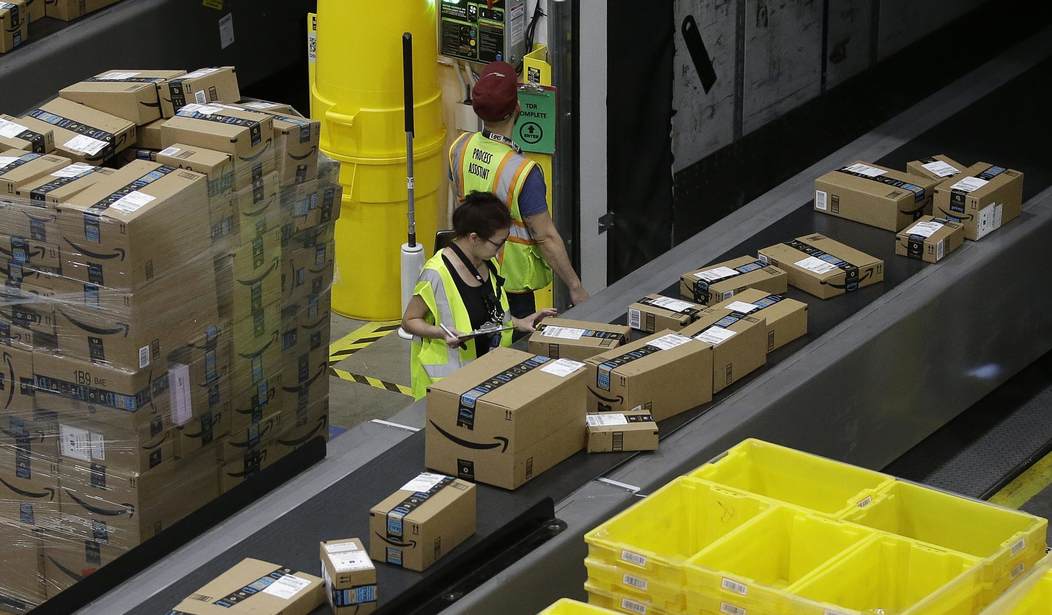Amazon swears it doesn’t want to turn its warehouse workers into “fleshy robots,” as alleged by writer Matt Novak in Gizmodo.
Amazon was granted two patents in January for the wristbands that are intended to show an employee how to use his hands most efficiently.
The company never mentioned any intention to use the wristbands to keep track of its workers on bathroom breaks, for instance, on or off the job. But that didn’t stop some privacy advocates and industry observers from warning of the creation of a dystopian time-management tool.
According to the Amazon patents, the idea is the wristbands would buzz and vibrate to nudge workers’ arms into a better position or even stop the worker from, let’s say, putting something in the wrong place or grabbing the wrong wrench.
“Existing approaches for keeping track of where inventory items are stored … may require the inventory system worker to perform time-consuming acts beyond placing the inventory item into an inventory bin and retrieving the inventory item from the inventory bid, such as pushing a button associated with the inventory bin or scanning a barcode associated with the inventory bin. … Accordingly, improved approaches for keeping track of where an inventory item is stored are of interest,” Amazon wrote in the patent documents obtained by GeekWire.
There is no mention in the documents of using the wristbands to track workers on their bathroom breaks, or anywhere else.
But Amazon was bothered enough by the plethora of privacy concerns that it issued a statement meant to calm the storm.
“The speculation about this patent is misguided. Every day at companies around the world, employees use handheld scanners to check inventory and fulfill orders. This idea, if implemented in the future, would improve the process for our fulfillment associates. By moving equipment to associates’ wrists, we could free up their hands from scanners and their eyes from computer screens,” read an Amazon statement Feb. 5 after GeekWire broke the wristband story.
Fair enough. But Don Gross editorialized in the socialist newspaper Liberation that since Amazon operates in a capitalistic environment, as do other businesses that might one day adopt this technology, their proclamation of nearly altruistic intent cannot be trusted.
“Even if Amazon’s statement is taken at its word, under capitalism, labor-saving technology is rarely developed for the benefit of the workers using it,” Gross wrote. “Under capitalism, the scientific and technological advancements made are being used to squeeze every last ounce of profit out of workers.”
The wristbands may never happen. But since patents were filed and granted, there is little doubt that they could be manufactured.
Max Crawford spent two years working inside Amazon warehouses in Britain. Although the ultrasonic pulse emitting wristbands were, of course, not in use, Crawford said the Seattle-based company had implemented other tracking technology.
“After a year working on the floor, I felt like I had become a version of the robots I was working with,” Crawford told the New York Times.
“There was no time to go to the loo,” he said, using the British slang for toilet. “You had to process the items in seconds and then move on. If you didn’t meet targets, you were fired.”
This isn’t new. The Times reported three years ago that Amazon’s management does not shy away from pushing its employees to the limit.
Amazon workers were pushed to work long and late with emails arriving in the early morning hours followed by texts from superiors if the messages were not answered promptly. Amazon encouraged its people to rat out each other via an internal phone directory and to tear apart each other’s ideas in public meetings.
“You walk out of a conference room and you’ll see a grown man covering his face,” Bo Olson told the Times. He left Amazon after less than two years. “Nearly every person I worked with, I saw cry at their desk.”
Would these wristbands be legal?
Paula Brantner, a senior advisor with the employee-rights organization Workplace Fairness, told CNN that making employment decisions based on employer-collected biometric data is a violation of the Genetic Information Act.
“I understand some employees might embrace it in a physically demanding position if it would help them do their jobs more efficiently with less effort. But at this point in time, I have more questions than answers about how it will be used,” Brantner said.
Tell it to the judge, right? Novak noted that Amazon was victorious in the U.S. Supreme Court in a lawsuit brought by some of the techno giant’s warehouse workers who complained they were being kept in security lines for nearly half an hour, unpaid, before they could go home.
“We can’t say that we weren’t warned about the employer surveillance complex. We’ve seen it pop up repeatedly in predictions from the early 2000s,” Novak wrote. “If these patents are any indication, the future looks even darker for the American worker.”









Join the conversation as a VIP Member